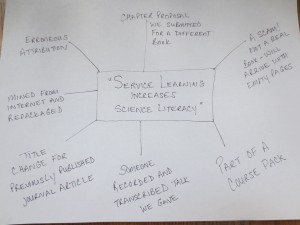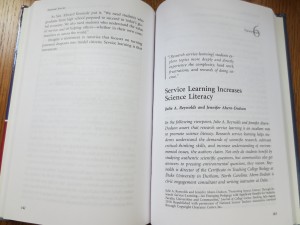Last week I was researching a copyright and fair use issue for a faculty member, and needed to see a copy of a book held by Duke’s Rubenstein Rare Book and Manuscript Library. As I explained the issue and what material I wanted to use to the Rubenstein staff, a researcher sitting nearby listened intently. As soon as we finished, she told me that she was the President of the Authors Guild and that they were suing Google over fair use. She began to explain to me why Google was wrong, but that the author for whom I was doing the research should be allowed to rely on fair use. When I introduced myself as a lawyer and copyright specialist for the Libraries, the conversation came to a polite but stilted conclusion.
This week, however, I got a chance to see more fully what that researcher, whose name is Roxana Robinson and who was giving a lecture that afternoon in the Library, has to say about Google, in a column she wrote for the Wall Street Journal called “How Google Stole the Work of Millions of Authors” (behind a paywall). Ms. Robinson, a novelist and biographer, unfortunately proves what I suspected at the time of our encounter, that her perspective on fair use is based on a preconceived idea about who are good users entitled to rely on fair use (authors) and who are bad, unworthy users (Google), rather than on an understanding of the careful legal analysis of specific uses that actually underlies these decisions.
The WSJ column employs some interesting rhetoric, starting with its title, which is clearly intended to provoke a visceral response. Many people have noted that the language of theft and stealing is inappropriate when the issue is copyright infringement. This point is made in great detail in William Patry’s book “Moral Panics and the Copyright Wars.” As is true for most crimes, the definition of theft includes an intention, a mental state or “mens rea” that is a required element of that crime. For theft this intention is “to deprive the true owner of [the personal property]” (definition from Black’s Law Dictionary, Seventh edition). Because of the nature of intellectual property, copyright infringement never meets this definition; that is why the law has a different word — infringement — for the unauthorized taking of someone else’s IP.
So the headline of Ms. Robinson’s column is legally incorrect and intended, I think, to stir up her base rather than to make an argument that could sway the Supreme Court (for more on this point, see the rebuttal published in Fortune “Why the Authors Guild is Still Wrong about Google’s Book Scanning“).
The column also makes a couple of sardonic remarks about quotes that can be found using Google Books. Here the argument breaks down pretty badly, because both of the quotes Ms. Robinson chooses, one from Shakespeare and one from Emerson, are in the public domain. Her effort to be ironic seriously backfires here, because her own column is actually proving the utility of the Google Books database in a way that emphasizes its lawful use of PD texts. Rhetoric has truly overcome logic.
It is worthwhile, nevertheless, to think a minute about the logic structure of the argument that what Google has done is infringement. Ms. Robinson makes the point that there are many books that were scanned by Google, that Google is a profitable company, and that no authorization for the scanning was asked for or given by the authors of the works that were scanned. All of this is true, of course, but it does not amount to an argument that Google has infringed any copyrights. What is missing, at least as I see it, is any notice that the authors have been harmed. The rhetoric of the column clearly tells us that the Authors Guild, and at least some individual authors who are involved in the lawsuit, are angry. But it does not explain a fundamental element of any tort action — harm.
The two courts that have considered this case both found that there was no harm done here — no negative impact on the market for or value of the works in question, to use the language that is part of a fair use analysis. Users cannot obtain any significant portions of books that are limited to snippet views; the AG’s own experts were unable to retrieve as much as 16% of any work using word searches and snippet results, and even that amount of text was randomized in a way that made reading a coherent piece of the work impossible. The is just no evidence that any sales are lost due to this finding aid, and it is quite possible that sales will be gained.
There is, of course, the question of a licensing market. But that is almost a silly question. A market for licensing scans to create an index has never existed, and it is impossible to imagine that any of the authors had such an idea in mind when they wrote their works. As Judge Leval said in his decision for the Second Circuit Court of Appeals, this is not really even a use of the work, it is a use of information about the work, for which a secondary licensing market simply is not appropriate. Creating such a market would be revolutionary, and it would do much more harm to the overall environment for books and reading than anything Google could think up. What the Authors Guild seems to be saying here is that Google should pay us for something we never thought we would or should get paid for, simply because they have a lot of money. Perhaps when we recognize how weak that argument actually is it becomes understandable that Ms. Robinson relied on overheated rhetoric rather than legal or logical arguments. But if the purpose of her essay is to convince people that the Supreme Court needs to take the case to right a serious wrong, it falls far short, and is unlikely to convince the nine citizens whose opinion on that issue matters the most.




